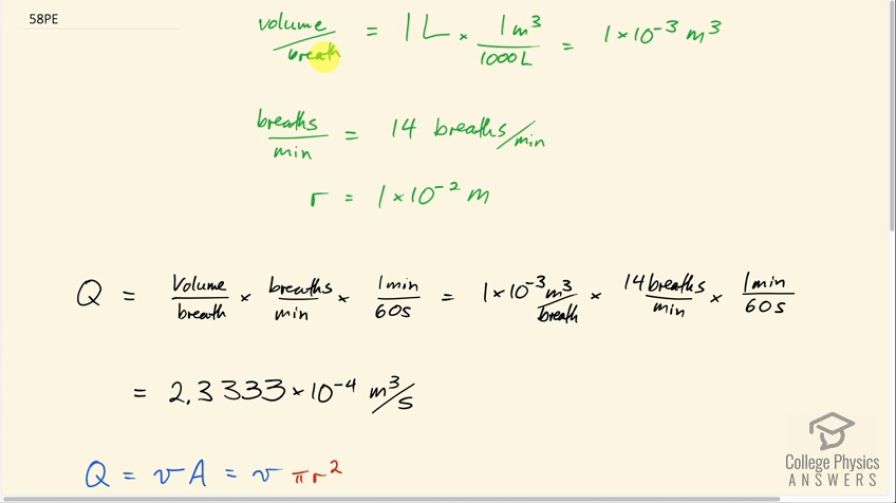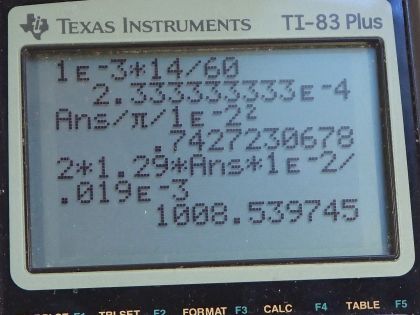Question
In Take-Home Experiment: Inhalation, we measured the average flow rate of air traveling through the trachea during each inhalation. Now calculate the average air speed in meters per second through your trachea during each inhalation. The radius of the trachea in adult humans is approximately m . From the data above, calculate the Reynolds number for the air flow in the trachea during inhalation. Do you expect the air flow to be laminar or turbulent?
Final Answer
The flow will be laminar.
Solution video
OpenStax College Physics for AP® Courses, Chapter 12, Problem 58 (Problems & Exercises)

vote with a rating of
votes with an average rating of
.
Calculator Screenshots
Video Transcript
This is College Physics Answers with Shaun Dychko. The take-home experiment about inhalation tells us that there is about one liter inhaled for every breath. We'll convert that into cubic meters in order to use this figure in our formulas. So, we multiply by one cubic meter for every 1000 liters which is one time 10 to the minus three cubic meters. And I looked up on google with the average number of breaths per minute is about 14 breaths per minute for a person at rest. And this question tells us the radius of the trachea which is the tube that your breath goes through is one times 10 to the minus two meters. So first of all figure out the speed of the airspeed in your trachea and we'll use this formula here that says that the volume flow rate is the speed of the fluid times the cross-sectional area of the pipe that it's going through which will have an area of pi r squared in this case because it's a circular cross-section and we can figure out what Q is based on this volume per breath and the number of breaths per minute which we convert into breaths per second here by multiplying by one minute for every 60 seconds. So, we have one time 10 to the minus three cubic meters per breath times 14 breaths per minute and then multiplied by one minute for every 60 seconds and we get 2.3333 times 10 to the minus four cubic meters per second. So, looking over here then we want to solve for v and we'll divide both sides by pi r squared and we get that the airspeed then is the volume flow rate divided by pi times radius squared. So that's 2.3333 times 10 to the minus four cubic meters per second divided by pi times one times 10 to the minus two meters squared which is 0.7 meters per second. Then it asks us whether the flow would be laminar or not. And so to answer that we need to calculate Reynold’s number and see if it's less than 2000. So we multiply two by the density of air times the airspeed times the radius of the trachea divided by the viscosity of air. So, that's two times 1.29 kilograms per cubic meter density of air times 0.7427 meters per second that we calculated up here but writing up with more decimal places because we don't want to have intermediate rounding error. Then we multiply by one times 10 to the minus two meters radius of the trachea divided by this viscosity of air which since we're in the body it'll be closer to 0.0190 than it will be to 0.0181 because body temperature is 37 degrees Celsius and this is milla Pascal seconds and so we have times 10 to the minus three Pascal seconds and I could have if I wanted to be more precise I could have taken in an average between 0.0181 and 0.0190 and see what the slope is of the viscosity versus temperature graph and then extrapolated what 37 degrees would give for viscosity assuming a linear relationship between these temperatures but anyhow that's all unnecessarily complicated for a question where we've just made assumptions about the breaths per minute and so on. We don't have that level of precision to warrant such a rigorous treatment of this quantity. We end up with a 1009 which is certainly less than 2000, so this is definitely laminar flow.
